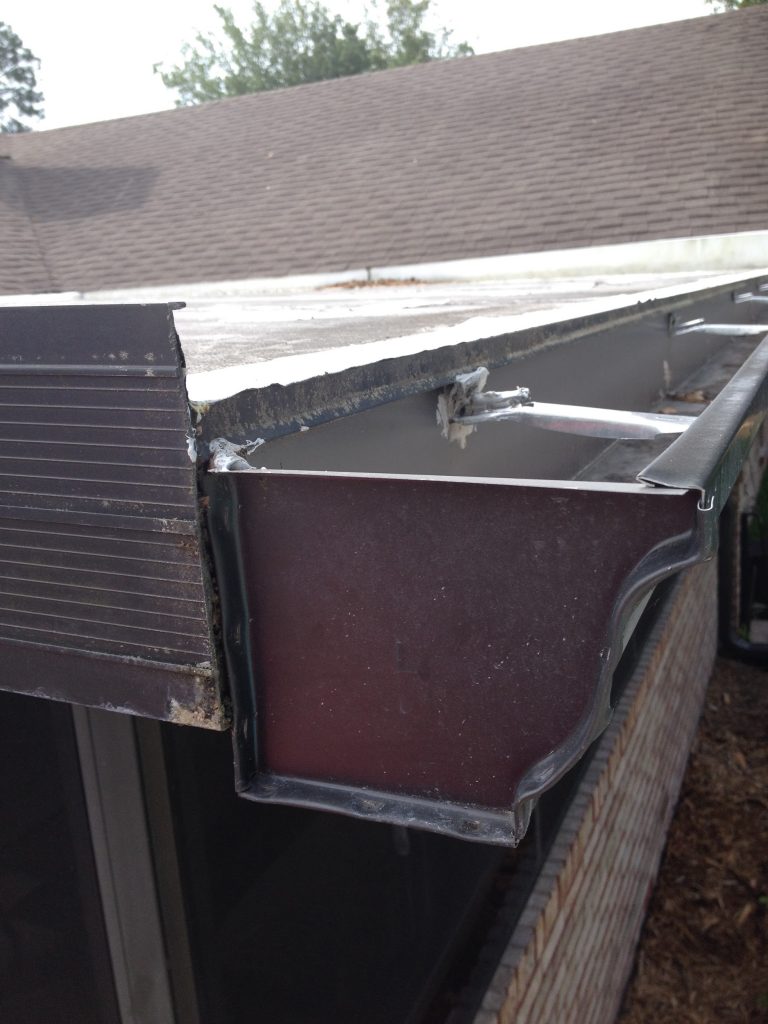Gutter Talk

Routine cleaning of the gutters on your home can prevent complex and costly problems by preventing damage to your roof, exterior, and foundation. Gutters need to be kept clean and free of debris so that water can drain properly, off of your roof, and away from your home. Consistent and proper maintenance of your gutters will help protect your home from a multitude of possible problems that can occur as a result of not maintaining your gutters regularly.
Failure to properly maintain your gutters can result in a variety of costly repairs that could have easily been prevented:
- Roof Damage – Leaves and debris can build up and clog gutters which can result in rot on your roof. Water that isn’t able to drain to the ground can pool on the roof, soaking through shingles, and causing significant damage.
- Infestation of pests – Clogged gutters are attractive to critters for nesting.
- Damage to fascia (the board that runs directly behind your gutter) – Overflowing waters from clogged gutters can cause damage to your fascia.
- Damage to brackets – Increased weight due to clogged gutters can lead to damaged and completely broken brackets, resulting in sagging and falling gutters.
- Mold – Leaky gutters and decomposing leaves sitting in a warm, muggy climate can create mold. In our wet climate mold is common and can cause a plethora of health problems if it gets inside your home.
- Overflowing gutters that aren’t draining properly can damage healthy plants – Overwatering can be just as bad as not watering for delicate plants.
So what should you look for? It’s important to note that if you are not sure what to look for or are uncomfortable climbing up a ladder to take a look around you should consider hiring a professional to do a gutter inspection and any cleaning or repairs necessary. If you feel comfortable climbing a ladder, great! A visual inspection of the gutters is the best way to check for damage and potential problems. Some things to check for that could signify it’s time to clean and maybe even repair or replace some of your gutters are:
- Dripping, overflowing, or clogged gutters – Water running over the sides of the gutters or not flowing through downspouts likely means a clog somewhere.
- Sagging gutters from the weight of debris.
- A “gutter garden” – If you are seeing plant growth in or on your gutters, rest assured the weight of the dirt, plants, and other debris is compromising the integrity of your gutters and they are not working properly to protect your home from water damage.
- Staining on the siding of your home – This could signify a spot where water flows over the side of the gutter due to a clog.
- Signs of animal life such as bugs in the house or mice in the attic – These critters could be nesting in clogged gutters. If you discover bird’s nests or other wildlife, call your local animal control center for advice.
- Pools of water on your driveway or lawn – This could mean that the water isn’t draining properly or far enough away from your home.
- Water where it shouldn’t be – Drips inside your home or pools of water inside lower levels of your home could mean a major problem and your roof or foundation could be at risk. Consult a professional immediately.
You should expect to inspect and clean your gutters at least two times a year depending on your tree coverage. If you have Pine Trees that shed needles year round its best to inspect and clean your gutters every three months. If you can’t remember the last time you inspected and cleaned your gutters – it’s been too long and it’s time!
Some things to remember while inspecting and cleaning your gutters that will help ease the process and also help you identify any potential problems:
- Cleaning gutters by hand is the most effective. Wear gloves. A high pressure hose can help clear out clogs in the downspouts.
- You can use a wet/dry vacuum to suck up all the leaves and debris if you have one with a long enough reach.
- Start closest to the downspout and remove debris as you work your way away from the downspout.
- Put gunk from the gutters into a trash can or compost. Tossing it down to the ground will attract unwanted bugs and critters.
- Clean any mold you find with a diluted solution of water and bleach in a spray bottle.
- Seal any leaks you find.
- Do not lean on the gutters. This could cause them to potentially come loose and could result in you falling.
- Clean out the trouble spots where debris tend to gather more quickly on a more regular basis.
- Pay attention to areas that often have standing water. These areas could be prone to additional damage caused by the water. Look for rust, holes, or cracks to indicate these sections may need to be replaced.
- Lastly, be safe. Do not do anything you are not comfortable doing. If you need to hire a professional, then do.


Follow these tips to keep your gutters in tip-top shape! With proper and consistent maintenance, the average gutter system should last about twenty years.
Happy Cleaning!
